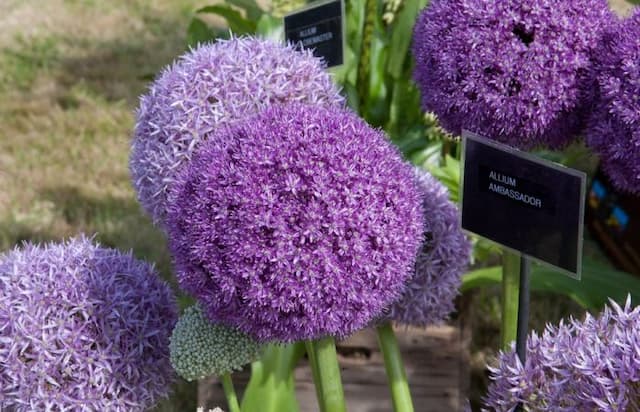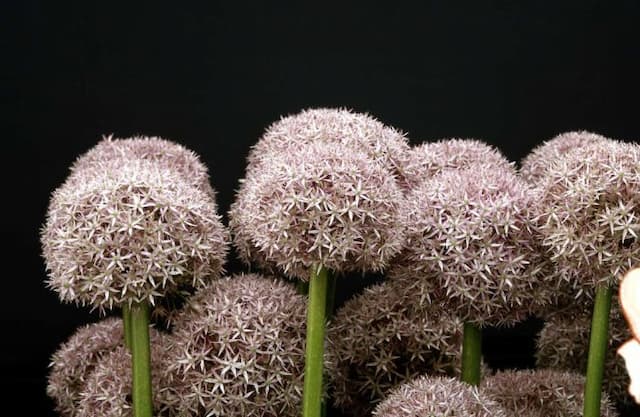Springstar Ipheion uniflorum 'Wisley Blue'

ABOUT
Ipheion uniflorum 'Wisley Blue', commonly known as spring starflower, is a striking plant that displays an array of delightful features. It presents narrow, green to bluish-green leaves that create a grass-like clump, often among the first to peek out after the winter. The most captivating aspect of the spring starflower is its charming blossoms. Each flower is star-shaped, with a multitude of petals radiating outward from the center, creating a bloom resembling a twinkling star. The flowers are typically a soft, sky-blue hue, giving 'Wisley Blue' its name, and they often showcase a subtle shimmer or iridescence under the sunlight. The petals can have a faintly darker stripe down the middle, adding to their depth and visual interest. With the blossoming of these flowers, they produce a sweet fragrance that is light and airy, contributing to the allure of the plant. These identifiable characteristics of the Ipheion uniflorum 'Wisley Blue' come together in a display that is simple yet enchanting, adding a touch of whimsy to gardens and landscapes where used. The spring starflower's soft blue flowers and attractive foliage make it a cherished addition wherever a cheerful and calming influence is desired.
About this plant
 Names
NamesFamily
Amaryllidaceae
Synonyms
Spring Starflower, Springstar, Wisley Blue Starflower
Common names
Tristagma uniflorum, Brodiaea uniflora, Milla uniflora, Triteleia uniflora, Beauverdia uniflora
 Toxicity
ToxicityTo humans
The Spring Starflower is generally considered to be non-toxic to humans. Therefore, ingestion of the plant typically does not result in poisoning or adverse symptoms. However, it is always advisable to avoid eating ornamental plants due to potential individual allergies or sensitivities which might cause mild discomfort.
To pets
To pets, the Spring Starflower is also regarded as non-toxic. If a pet ingests parts of this plant, it is unlikely to experience adverse health effects or poisoning. Nevertheless, as with humans, ingestion of plant material can sometimes lead to mild gastrointestinal upset because of the novelty and fiber content.
 Characteristics
CharacteristicsLife cycle
Perennials
Foliage type
Deciduous
Color of leaves
Green
Flower color
Blue
Height
4-6 inches (10-15 cm)
Spread
3-6 inches (7.6-15.2 cm)
Plant type
Bulb
Hardiness zones
5
Native area
South America
Benefits
 General Benefits
General Benefits- Low Maintenance: Requires minimal care once established, making it ideal for gardeners of all skill levels.
- Drought Tolerant: Once established, it can withstand periods of dry weather, reducing the need for frequent watering.
- Attracts Pollinators: Flowers are known to attract bees, providing a food source for these beneficial insects.
- Naturalizing: Spreads easily and can form attractive drifts or carpets of color in the garden over time.
- Deer Resistant: Less likely to be eaten by deer, which can be an advantage in areas where deer are a common garden pest.
- Early Bloomer: One of the first flowers to bloom in spring, bringing color to the garden after winter.
- Multipurpose: Suitable for use in rock gardens, borders, and as a ground cover due to its compact growth habit.
- Long Blooming: Provides a long period of bloom in comparison to other spring flowers, offering extended color and interest.
- Easy to Propagate: Can be easily multiplied by dividing clumps after several years, allowing gardeners to expand their displays or share with others.
- Cold Hardy: Able to survive and thrive in cooler climates, making it a versatile addition to many gardens.
 Medical Properties
Medical PropertiesThis plant is not used for medical purposes.
 Air-purifying Qualities
Air-purifying QualitiesThis plant is not specifically known for air purifying qualities.
 Other Uses
Other Uses- Spring Starflower bulbs can be crushed to create a natural glue due to their sticky sap which adheres well to paper and light wood materials.
- The crushed leaves of Spring Starflower can be used to add a gentle, onion-like flavor to homemade potpourris.
- When dried, the flowers can be used in decorative crafts such as making bookmarks and greeting cards by pressing them to preserve their star-like shape.
- Spring Starflower plants can serve as a living mulch under shrubbery, suppressing weeds while providing a lush ground cover.
- Its robust nature allows it to be used in erosion control projects on sloping landscapes to help retain soil.
- The unique coloring and star shape of the 'Wisley Blue' flowers provide an excellent source of natural dye for fabrics and yarns.
- Children’s garden projects can incorporate planting Spring Starflower to teach bulb planting and growth observation due to their easy cultivation.
- Their early bloom time can be used to assist in phenological studies as markers for tracking the arrival of spring.
- In culinary arts, delicate Spring Starflower petals can be crystallized with sugar to decorate desserts, due to their edible nature.
- Used in landscape photography, Spring Starflower offers a vibrant pop of color to early spring scenery shots.
Interesting Facts
 Feng Shui
Feng ShuiThe Spring Starflower is not used in Feng Shui practice.
 Zodiac Sign Compitability
Zodiac Sign CompitabilityThe Spring Starflower is not used in astrology practice.
 Plant Symbolism
Plant Symbolism- Hope: Ipheion uniflorum 'Wisley Blue', commonly known as Spring Starflower, often heralds the arrival of spring and is associated with the renewal that season brings, symbolizing hope and new beginnings.
- Persistence: The Spring Starflower is known for its hardiness and the ability to bloom in early spring, even when the weather is still cold and unpredictable, representing persistence and resilience.
- Innocence: The delicate and unassuming appearance of the Spring Starflower often carries the symbolism of purity and innocence, much like many small and light-colored flowers do.
 Water
WaterSpring Starflower should be watered moderately when in active growth, ensuring the soil is moist but not waterlogged. During the spring and early summer, watering once a week with about one gallon per square yard should suffice. As they are drought-tolerant once established, you can decrease watering frequency to once every two weeks or less, depending on rainfall and temperatures. After the plant has finished flowering and the leaves start to yellow, reduce watering considerably to simulate dry summer conditions. Give a light watering only if the soil becomes very dry.
 Light
LightSpring Starflower prefers full sun to light shade. The best spot for the plant would be in a location where it receives at least four hours of direct sunlight daily. While it can tolerate partial shade, the blooms are most abundant when the plant is placed in an area with ample sunshine.
 Temperature
TemperatureSpring Starflower thrives in temperatures ranging from about 60 degrees Fahrenheit to 75 degrees Fahrenheit. They are hardy and can survive temperature dips down to 20 degrees Fahrenheit, but for optimal growth and flowering, maintaining temperatures within the ideal range is best. Avoid exposing the plant to temperatures above 80 degrees Fahrenheit for prolonged periods.
 Pruning
PruningSpring Starflower doesn’t require rigorous pruning, but deadheading spent flowers will encourage a tidier appearance and potentially more blooms. Pruning should be done after flowering by removing dead flower heads. The foliage should be left to die back naturally and cleaned up once it has turned yellow and withered, usually in late summer.
 Cleaning
CleaningAs needed
 Soil
SoilSpring Starflower prefers well-draining soil rich in organic matter with a neutral to slightly alkaline pH of around 7.0-7.5. A soil mix combining garden soil, compost, and sand or perlite would be ideal to provide the necessary drainage and nutrients.
 Repotting
RepottingSpring Starflower typically does not need frequent repotting and can be done every 2-3 years or when the clumps become overcrowded. They can be divided during repotting to propagate new plants.
 Humidity & Misting
Humidity & MistingSpring Starflower does not require high humidity levels and can thrive in average garden humidity conditions. It is more tolerant of dry air than excessive moisture.
 Suitable locations
Suitable locationsIndoor
Grow in bright light, well-draining soil, and cool temperatures.
Outdoor
Plant in well-draining soil, full sun to part shade.
Hardiness zone
5-9 USDA
 Life cycle
Life cycleIpheion uniflorum 'Wisley Blue', commonly known as the Spring Starflower, begins its life cycle with seed germination, which occurs in autumn when soil temperatures drop. The seeds develop into bulbs, which are the plant's storage organs, and these take root and establish themselves in the soil. In late autumn or early winter, the bulbs send up slender, grass-like foliage. The Spring Starflower enters its flowering stage in early to mid-spring, producing delicate, star-shaped flowers with a soft blue color and a sweet fragrance. After flowering, the plant sets seed while the foliage begins to die back, marking the end of its above-ground lifecycle. The bulbs enter a dormant period during the hot summer months, conserving energy to start the next cycle when the temperatures cool again.
 Propogation
PropogationPropogation time
Spring to Summer
Ipheion uniflorum 'Wisley Blue', commonly known as Spring Starflower, is best propagated by dividing the bulbs. The ideal time for this form of propagation is in late summer to early fall, after the foliage has died back but before new growth begins. To propagate, carefully lift the clump of bulbs out of the ground using a garden fork to minimize damage. Gently separate the offsets, small bulbs which form around the base of the mother bulb, from the main bulb. Each offset should have some root growth attached. Replant these bulbs immediately at a depth of about 3 inches (about 7.5 cm), spacing them approximately 3 inches apart to ensure adequate room for growth. This process not only helps to propagate new plants but also rejuvenates older clumps that may have become too dense.









